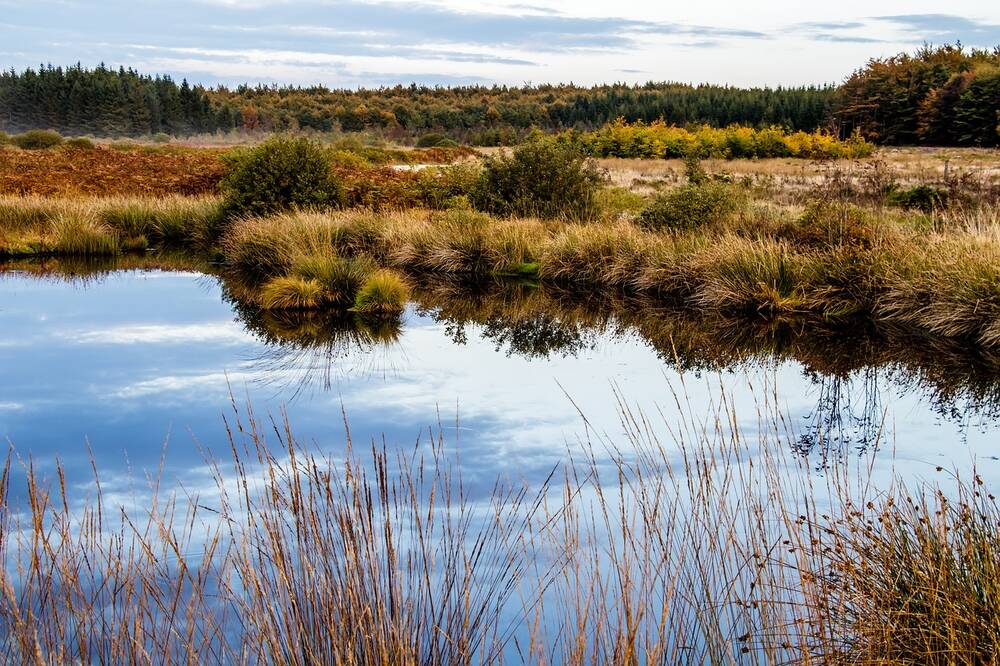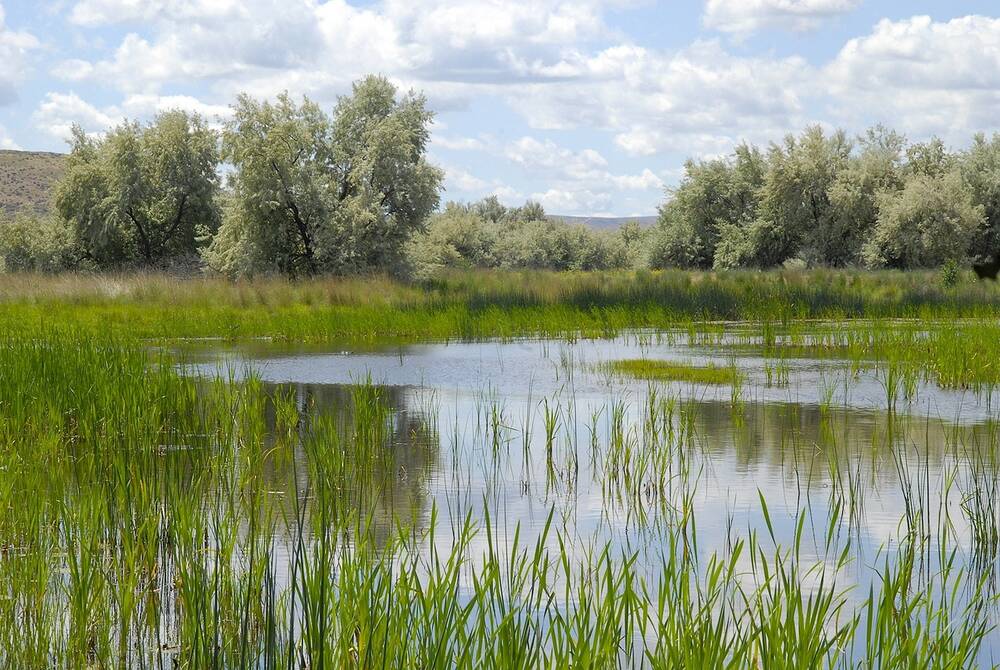Wetland habitats encompass a diverse range of ecosystems that blend terrestrial and aquatic environments, supporting water-dwelling species, land species, and those adapted to both.
This article explores the key features of wetland habitats, why they are so ecologically valuable, the benefits they have against climate change and the dozens of different types of specific habitats within wetlands, including their specific ecological contexts and characteristics. It then explores the plant and animal species that reside within wetlands, then covers some of the key threats they are facing. Finally, we cover some related statistics and some real-life examples of significant wetlands around the world.
What are Wetland Habitats?
Wetland habitats are transitional areas between land and water ecosystems—such as estuaries, rivers, and lakes—meaning that they offer a rich variety of habitats supporting a range of terrestrial and aquatic species.
Their soils will be flooded or saturated for the majority of the year, with shallow-standing or periodically inundated water, such as vernal pools or floodplains.
Wetland habitats vary, from marshes and swamps to bogs, and each type has its own distinct functionalities. For instance, freshwater marshes filter nutrients, but swamps can host large trees like cypresses providing valuable habitats.
Key Features of Wetland Habitats

A defining characteristic of wetland habitats is their saturated, waterlogged soils, creating an anaerobic (low-oxygen) environment in the soil and under the water, which hosts a unique range of species.
Wetlands are home to many hydrophytic (water-loving) plants that are well-adapted to wet soils, such as water lilies and bulrushes, which maintain soil structure and provide shelter and food for wildlife.
The habitat’s periodic flooding or shallow water regulates water levels, offering flood control services and groundwater recharge.
What’s more, their distinct mix of land and water habitats is relied on for many amphibious species like frogs, beavers and herons, creating rich ecosystems of biodiversity.
Why Wetlands are Important
Wetlands provide invaluable environmental benefits, offering ecosystem services that greatly enhance human well-being. They regulate the climate and aid the fight against global warming, and they challenge the biodiversity crisis by providing vital habitats for a diverse range of land and water species.
Climate Change Mitigation
Wetlands sequester massive amounts of carbon as their dense, waterlogged soils release slow amounts of carbon over time. When wetlands are drained, such as for agricultural purposes, the soils then re-release the carbon and contribute to global warming.
Peatlands in the UK, for example, are said to store more carbon than all of Britain’s forests combined.
Natural Water Filters
Wetland habitats essentially filter our water by slowing down water flow, allowing suspended sediments to settle which cleans water downstream.
Healthy wetlands are packed full of diverse plant species that absorb excess nutrients like phosphorus and nitrogen, preventing algae blooms (a thick coating of algae atop a water body that suffocates all plant life beneath it).
Flood Control
Wetlands operate like sponges—when it rains a large amount, they suck it up and store it, reducing the risk of floods. High winds and storm surges pose significant risks to coastal communities.
In the Philippines, for instance, the mangrove forests protect villages from typhoons and storm surges. The wetlands slow water flow, preventing flash flooding, erosion, and protecting infrastructure.
Groundwater Recharge
Another benefit of wetlands is groundwater recharge—wetland soils allow water to seep into aquifers, which are underground layers of sediment or rock that store water.
The stored water can then be accessed by drilling wells down to the aquifer, then drawing the water up with a pump, for irrigation, drinking, or any other needs.
Around a third of the UK’s drinking water supply comes from groundwater stored in aquifers.
Biodiversity Hotspots
Wetlands offer habitats for many endangered or rare species, such as the Florida panther or the American crocodile in the Everglades.
From the range of land and water habitats, they provide many safe spaces for breeding and shelter—swamps with large trees can support mammals and birds, while the marshes support rare insects and waterfowl. These complex food webs contribute to rich, diverse ecosystems. Wetlands also operate as many stopover points for migratory species.
Shoreline Stabilization
Wetlands essentially stabilise shorelines as wetland plants lock soils in place, such as common reeds, mangroves or cattails. They absorb the energy of the waves and protect coastal areas from being worn down. As a result, it maintains natural coastline patterns, instead of allowing shorelines to be washed away by currents or waves.
Ecosystem Productivity
Wetland ecosystems support complex food webs, leading to high levels of productivity. Their diverse range of species leads to high plant material and biomass, providing food for many animals and creating resilient ecosystems.
They cycle nutrients through plant uptake, decomposition, and microbial processes, sustaining biodiversity and thriving wildlife.
The Different Types of Wetland Habitat

Wetlands can contain dozens of different habitat types as they lie within transitional zones between aquatic and terrestrial environments. Their diverse plant life, from floating and submerged species to tall trees and reeds, all form diverse habitats for wildlife.
What’s more, their water levels can vary with the seasons, supporting unique species at different times of the year, with temporary habitats like vernal pools and mudflats.
Marshes
Marshes are waterlogged areas that filter water, control floods, and offer habitats for many diverse bird species. They’re found in saltwater and freshwater environments and contain soft-stemmed vegetation. Decomposing plants fuel nutrient cycles, allowing for thriving biodiversity from microbes to large mammals.
Swamps
Swamps are forested wetlands with water-tolerant shrubs and trees, supporting complex food webs with predators like eagles and alligators as well as smaller fish, amphibians and mammals. Swamps trap sediments and pollutants, purifying and filtering water, and are usually found near rivers or in floodplains.
Rivers and Streams
Rivers and streams are bodies of flowing freshwater, transporting nutrients, supporting ecosystems and shaping landscapes, while also operating as ecological corridors to crucially connect fragmented ecosystems and allow species to travel through areas.
Estuaries
Estuaries are the areas where the river meets the sea, mixing freshwater and saltwater to get brackish waters, supporting rare species. They promote biodiversity in coastal regions and can operate as nurseries for fish while buffering the coasts from storms.
Saltmarsh
Salt marshes occur when coastal wetlands become flooded with saltwater tides, consisting of low-lying, flat areas with sandy or muddy substrates. They tend to be dominated by salt-tolerant vegetation like grasses and can develop along estuaries or behind barrier islands.
Peat Bogs
Peat bogs are waterlogged wetlands that accumulate thick layers of peat, storing vast amounts of carbon. They have highly acidic and nutrient-poor conditions, meaning they host a variety of specialised rare mosses and plant species, such as carnivorous plants.
Floodplains
Floodplains are flat areas near rivers prone to periodic flooding. Over time, rivers deposit alluvial, rich soils, making floodplains some of the most fertile lands, supporting diverse ranges of wildlife that thrive in water-rich environments. They slow the risks of downstream flooding and recharge groundwaters.
Lakes
Lakes are still, large bodies of freshwater, usually bordered by land and up to hundreds of kilometres in size. Lakes can be packed with many species especially when they consist of many distinct zones, from sunlit, littoral zones to darker regions with a lack of light. This results in diverse, thriving ecosystems while also regulating local climates by absorbing and storing heat.
Mangroves
In tropical and subtropical coastal wetlands, mangroves consist of salt-tolerant shrubs and trees with stilt-like root systems which grow below and above the water in order to combat tidal forces and high salt quantities.
Reedbeds
Reedbed habitats form along the edges of ponds, rivers, and lakes, dominated by tall, densely packed reed plants in shallow and slow-moving or still waters. Their thick vegetation can offer safe shelter, breeding grounds, and a variety of food sources for wildlife.
Wet Grasslands
Wet grasslands resemble marshy fields or lush meadows. They consist of low-lying, open areas packed with wildflowers, sedges and water-tolerant grasses, and tend to experience seasonal flooding with constantly moist soils.
Wet Woodlands
In contrast, wet woodlands are forested wetlands occurring alongside streams and rivers. They feature species that can thrive in moist conditions, like alder, willow and birch, and host a rich range of shade-tolerant plants like mosses and ferns, as well as invertebrates, birds, amphibians and mammals.
Coral Reefs
Coral reefs are underwater, interconnected structures found in shallow, warm waters of tropical and subtropical oceans. They biodiversity hotspots, with vibrant coral reefs hosting thousands of species of fish, marine mammals and invertebrates.
Ponds
Ponds are smaller and shallower than lakes, typically not exceeding a 2-metre depth, and support aquatic or amphibious species in areas where there might be a lack of water. Ponds can be man-made, integrated into landscapes for aesthetic or ecological value, or naturally occurring, creating vital habitats for wildlife.
Seagrass Beds
A seagrass bed is an underwater meadow made found in shallow coasts, creating a dense sea floor with roots, stems and leaves anchored into the seabed. In sunlit waters these thrive, in temperate and tropical zones, and stabilise sediments while absorbing nutrients.
Vernal Pools
A vernal pool is a temporary habitat that forms during rainy seasons when water collects in natural depressions in meadows, woodlands, and grasslands. These pools provide a natural environment for specialised plants adapted to intermittent water availability, with some species even aligning their breeding cycles to coincide with the pool’s seasonal appearance.
Ditches and Scrapes
Ditches and scrapes are man-made channels that tend to be shallow, collecting water for irrigation, flood control, or drainage. The artificial wetlands can border fields for agricultural purposes, and hold water year-round or seasonally, providing habitats for small animals and aquatic plants.
Fens
A fen is a wetland with slow-moving or still water, with alkaline, mineral-rich soils and a spongy surface, packed with grasses, sedges and special wetland plants. They form lush areas of vegetation with unique plant communities like rushes and orchids, alongside dragonflies, butterflies and damselflies, usually in temperate regions.
Lagoons
Lagoons support diverse ecosystems with brackish waters in shallow coastal areas, separated from oceans by coral reefs, sandbars or spits. They are found near coasts where sediment deposits occur, leading to sheltered habitats ideal for a range of aquatic wildlife.
Tidal Flats
Tidal flats are expansive, flat areas made of silt, sand or mud, between the high and low tide marks within a coast. They are periodically submerged, and found commonly in bays, estuaries, and areas with minimal wave action, supporting many mud-dwelling organisms.
Mudflats
Mudflats are coastal wetlands formed in sheltered areas where rivers join with the sea. Their nutrient-rich, fine sediments result from slower movements of water, and they appear smooth and flat when the tide departs. They host many organisms adapted to low-oxygen conditions, like mollusks, worms and crabs, as well as many wading and migratory birds.
Playa Lakes
A playa lake forms after rainfall in flat basins, creating a temporary, shallow ephemeral lake, from just a few centimetres all the way to a few metres. They play a crucial part in groundwater recharge in desert areas and support specialised species such as salt-tolerant plants or migratory birds. When drying out in summer, mineral deposits are left behind from playa lakes, further enriching soils and supporting the desert’s ecosystem.
Prairie Potholes
Formed by glacial activity 11,000 years ago, prairie potholes are seasonal bowl-shaped depressions that dry out in summer but form temporary ponds in spring. They offer breeding habitats for many waterfowl, insects and amphibians.
Riparian Wetlands
Riparian wetlands are found along freshwater bodies like streams and rivers and may contain forests, shrubs, or grasses depending on ecological conditions. Their fluctuating levels of water lead to rich, moist soil supporting ranges of biodiversity.
Animals & Plants That Live In Wetland Habitats

Fish and Aquatic Animals
Wetlands host many fish and aquatic animals either adapted to freshwater or brackish environments. They provide many nurseries for young fish, with dense aquatic vegetation sheltering the young from predators. The fish consume mosquito larvae and other insects, keeping populations balanced. The wetlands also operate as migratory stopovers for fish such as salmon, allowing them to feed and rest.
Mammals
Many mammals thrive in wetland areas, including semi-aquatic species like beavers, which build dams that alter water flow and create new habitats for invertebrates, fish, and other species.
Otters control fish populations, whereas smaller mammals like muskrats act as prey for the larger predators.
Mammals act as ecosystem links, feeding on both terrestrial and aquatic plants and animals.
Birds
Wetlands support birds of prey, songbirds, wading birds, waterfowl, and migratory birds, feeding on the many sources of fish, insects, plant matter, or crustaceans. As a result the birds control insect populations while contributing to seed dispersal; enhancing ecosystem resilience and enriching biodiversity.
Reptiles & Amphibians
In wetland environments, amphibians like frogs, newts and salamanders live alongside reptiles like snakes and turtles. Many species rely on a wetland habitat for their breeding grounds, in specific areas that allow their larvae to develop. Amphibians can be a prolific indicator of wetland health, as they are highly sensitive to changes in ecological conditions.
Plants
Across the vast spectrum of wetland habitats, many plants thrive. Most commonly, plants that are well-adapted to the wetlands’ waterlogged conditions are found, like cattails, water lilies, reeds, mangroves and bulrushes.
Threats & Conservation
Some of the worst threats to wetland habitats are pollution from urban areas and runoff from agriculture; harming ecological conditions and weakening ecosystems.
Climate change poses a range of risks, with rising temperatures changing weather patterns and disrupting established natural cycles.
Overfishing is also a threat to natural wetlands.
Furthermore, losses of biodiversity worldwide have led to a rise in invasive species populations.
As a result, degraded wetlands around the world are being restored through various initiatives and projects, and new wetlands are being created altogether. Read our recent blog here for an in-depth coverage of wetland restoration and creation.
Wetland Habitats Facts & Stats
Did you know that approximately 200 new species are discovered each year in freshwater wetlands? However, since 1970, we have lost a staggering 35% of global wetlands, largely due to pollution, urbanisation, and other human-driven factors. This loss is particularly concerning because wetlands are critical ecosystems, supporting around 40% of the world’s biodiversity. The habitats provide essential resources and living spaces for countless species, emphasising their need for conservation, restoration and recreation.
Famous Wetlands in the World
One of the most famous wetlands in the world is The Everglades in Florida, USA, supporting manatees, alligators and many bird species. It provides critical habitats for endangered species, and many conservation and restoration initiatives are restoring the prolific wetland habitat.
Another significant wetland is The Pantanal in Brazil, the world’s largest tropical wetland with one of the highest levels of biodiversity. The wetland is home to countless bird species, plus capybaras and jaguars.
More Information
https://www.worldwildlife.org/stories/what-is-a-wetland-and-8-other-wetland-facts
https://www.wetlands-initiative.org/what-is-a-wetland
https://data.jncc.gov.uk/data/b0b5e833-7300-4234-8ae5-bdbf326e854c/habitat-types-lowland-wetland.pdf
https://www.worldwildlife.org/stories/what-is-a-wetland-and-8-other-wetland-facts
https://www.global-wetland-outlook.ramsar.org/https://www.wwt.org.uk/our-work/why-wetlands/

